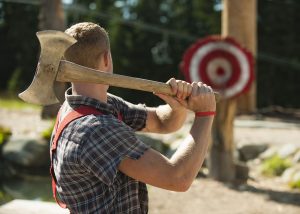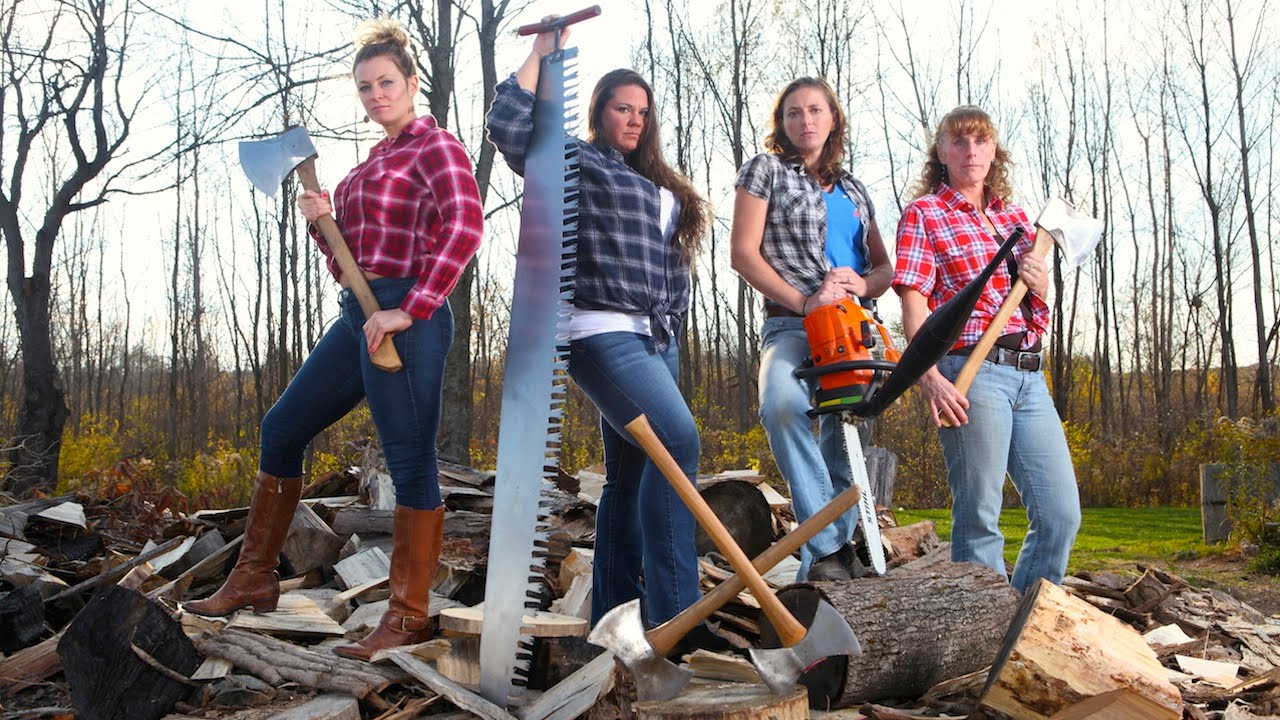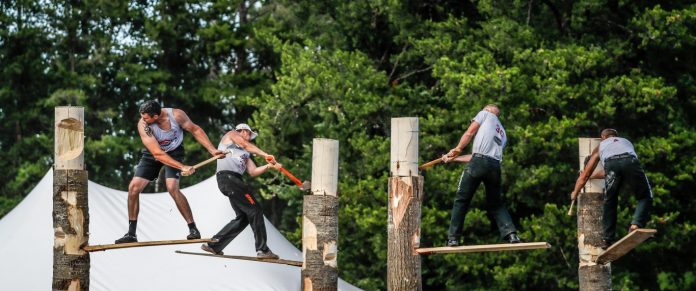Jack and Jill went down the hill to roll on logs in the water. This might not be how the traditional children’s rhyme goes, but to lumberjacks and lumberjills, this is how they roll. And climb, and chop, and split, and…
In certain forested regions around the globe, men and women don their plaid shirts, work boots, and blue jeans, and oil their chainsaws for the ultimate in the wooded world of sports: lumberjack sports. And these timber titans have literally got an axe to grind.

Woodsy Sports
Lumberjack sports, also known as timbersports, logging sports, or woodsmen teams, have one thing in common: it’s all about the wood. Each year, large audiences attend or tune in to watch lumberjack competitions from collegiate, amateur, and professional competitors.
It is said that the first logging sport started as an argument between two loggers in Tasmania in 1870. What began as a standard boast turned into an actual contest proving who could chop down a tree faster.
People gathered, bets were wagered, and the chopping began. 150 years later, thousands of people watch lumberjack competitions to see who can fell a tree the fastest.
But lumberjack sports have since evolved to add a wide variety of timber trials and tribulations to see who is at the top of the totem. While speed chopping is still a vital part of the process, most lumberjack sports feature some variation of the following events and competitions.
Each of the major and minor lumberjack competitions is organized by age group and skill level (junior, amateur, and pro), with plenty of action for lumberjacks and lumberjills alike.
The premier logging event is the annual Lumberjack World Championships in Hayward, Wisconsin. Started in 1960 at the Lumberjack Bowl, it features more than 20 lumberjack events and over $50,000 in prize money.
 Over 100 competitors from around the world compete in the Lumberjack World Championships each year.
Over 100 competitors from around the world compete in the Lumberjack World Championships each year.
Note: these are tough sporting events, and lumbersexual hipsters need not apply.
Chopping Competitions
The obvious core of lumberjack sports involves the liberal application of an axe to a tree. Competitors race against the clock in the speed chopping contest, a race to see who can chop down a tree the fastest.
But there are other types of chopping competitions in the lumber league. Competitors participate in the standing chop, springboard chop, underhand chop, and standing block chop.
The block chop is just what it sounds like: contestants whack away at a block of wood to see who can get through the block the fastest. Contestants use a single-bit axe to chop a 12-inch diameter log for lumberjacks, and an 11-inch diameter log for lumberjills.
In the ultimate test of balance and axe wielding, watch the springboard chop. Competitors must jam a piece of wood (a springboard) into notches cut into a tall tree and chop the top of the tree while standing on the narrow board.
Sawing Competitions
They came, they sawed, they conquered. This is the single buck competition. Using a tree saw called a bucking saw, contestants use a one man saw to cut through a 20-inch diameter log, or a 16-inch log for women.
 The double buck competition is the same sawing competition with two people pulling the saw.
The double buck competition is the same sawing competition with two people pulling the saw.
Unlike your garden variety hand saw, the buck saw has tall, spiked teeth fixed to a long, flexible saw blade. In the right hands, it cuts through wood like warm butter.
There is also a double bucking competition for men and women to compete together: The Jack and Jill.
The hot saw competition involves a powered chain saw. In this competition, contestants use a single cylinder power saw to make three cuts on a 20-inch diameter log.
Throwing Competitions
There is more to an axe than merely chopping. Any lumberjack or lumberjill worth their beef jerky needs to know how to throw an axe with pinpoint accuracy (it’s probably in the job description).
 The axe throwing event probably grew out of a common pastime for bored lumberjacks in days of old. When they weren’t chopping trees, they chucked the axe around for accuracy (and probably wagers).
The axe throwing event probably grew out of a common pastime for bored lumberjacks in days of old. When they weren’t chopping trees, they chucked the axe around for accuracy (and probably wagers).
These days, the lumberjack sports arena features axe throwing. A circular wooden board much like a dart board is placed 21 feet from the throwing line. The contestant chucks a double-bladed axe at the target for points.
Each thrower has five throws. The center is the bullseye as in darts, and it’s worth five points. The point value of each target circle decreases by one point until the outer circle. If a competitor misses, the throw is disqualified.
Climbing Competitions
Of all the things a lumberjack can do to a tree, the least destructive would be the most obvious: tree climbing. The speed climb combines the need for speed with tall timber into one exciting event.
Woodsy athletes use only spiked shoes and a climbing rope to race up and down a 90-foot-tall cedar pole. There is also a 60-foot climbing event. After racing to the top, the competitors slide down at lightning speed.
Water Competitions
All that chopping, chucking, climbing, and cutting wood makes for some hot and tired lumberjacks and lumberjills. Fortunately for them, they can cool off with the log rolling competitions in the water.
 Two opponents climb onto a floating log, then spin it rapidly in the water with their feet. Then they use special gripping shoes called birling shoes to suddenly stop the log mid-spin.
Two opponents climb onto a floating log, then spin it rapidly in the water with their feet. Then they use special gripping shoes called birling shoes to suddenly stop the log mid-spin.
The idea is to force the other opponent to fall off the log into the water. This is called ‘wetting.’ The contest continues with logs of increasingly smaller sizes and the contestant with the least number of falls wins.
Another aquatic timbersport is the boom run, which involves a string of logrolling logs chained together dock-to-dock across a pond. Two competitors run head-to-head on adjacent booms to the finish line on the other side of the pond.
And running on slippery, bobbing, rotating logs is much harder than it sounds. Anyone not up to the task will be waterlogged.
All-Around Champion
Each year, men and women take home top prizes in each category. But the true test of a lumberjack or lumberjill is in the grandaddy of all lumberjack sports, the Tony Wise All-Around Champion award.
Named after competition founder Tony Wise, this award is about endurance, and the winner of this coveted prize goes to the athlete who competes in as many events as possible.
The winner must earn the highest combined point scores from the underhand chop, standing chop, springboard chop, single buck, double buck, hot saw, Jack & Jill, logrolling, boom run, and the 60-foot and 90-foot climb.
And that is an awful lot of lumber to jack.
Timber!
As the final trees fall in the woods, thousands of people witness the happenings. Lumberjack sports are all about strength, speed, endurance, accuracy, and true grit.
Many of the competitors are professional lumberjacks and lumberjills, but the wide world of woodsy sports is open to all levels of competitors.
In some regions, children begin training for logrolling classes as young as 10 or 11. Squamish, British Columbia, hosts a four-week long Timber Training program for budding lumberjacks and lumberjills of all ages.
And after all the training is done and summer camp is over, many of these children will grow up and become big enough to swing an axe.
Let the lumberjack games begin!

Disclaimer: All images are copyright of their respective owners and are used by USA Online Casino for informational purposes only.










